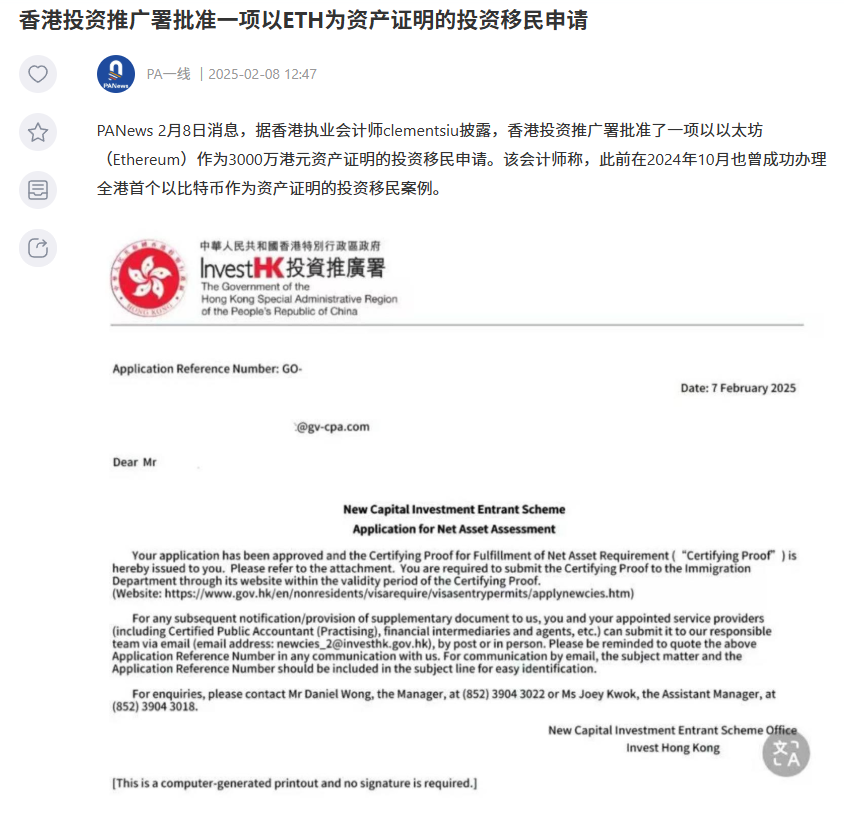It sounds like cryptocurrency players have found a “shortcut”, but in actual operation, many large currency holders are stuck in a key link-proof of source of funds (SOF).

Recently, Invest Hong Kong approved a “new thing”: someone used HK$30 million of Ethereum (ETH) as proof of assets and successfully applied for investment immigration. This is not the first time. In October last year, there was also a case of using Bitcoin to “customs clearance”. It sounds like cryptocurrency players have found a “shortcut”, but in actual operation, many large currency holders are stuck in a key link-proof of source of funds (SOF). Today, let’s talk about what’s going on.
1. Why can cryptocurrency be used as “proof of assets”?
According to Hong Kong’s New Capital Investor Entry-Scheme, applicants need to prove that they beneficially own (or share with their spouse) at least HK$30 million in assets, including stocks, bonds, deposits, real estate, etc. There are two core logic for cryptocurrency to be accepted:
1. The policy does not explicitly prohibit it: the Hong Kong government is open to asset types, and as long as the accountant can issue a report to prove that these assets actually exist and belong to the applicant, they will theoretically meet the requirements.
2. There are precedents in the market: According to the industry partners I have met, they have already had many similar cases. From Bitcoin to Ethereum, as long as the process is compliant, cryptocurrency is no essential difference from stocks or real estate.
But here’s the question: Proving you have money “and” Proving how you got your money “are two different things.
2. The biggest difficulty: Proof of Source of Funding (SOF)
There is a classic contradiction in the cryptocurrency circle-“The money can be taken out, but the money cannot be explained clearly.”
– Early players had a lot of “dark history”: many people obtained coins through mining, over-the-counter transactions and even “gift from friends” in their early years, but they could not get bank records or transaction records at all.
– The “thunder” of the exchange has dragged it down: Platforms such as FTX and Binance have experienced compliance problems, and some users ‘historical data has been lost or not recognized by regulators.
– Anonymity is a double-edged sword: Although blockchain is transparent, it is difficult to directly link wallet addresses to real identities, and it is difficult for accountants and immigration authorities to trace the source of funds.
For example: a large household spent 1 million Hong Kong dollars on Bitcoin in 2017, which is now worth 10 million Hong Kong dollars. But the transfer records of that year have long disappeared, or the transaction was in cash. How can we prove that the 100,000 yuan is legal income? If you can’t explain this, the immigration application will go straight.
3. The “dilemma” for accountants: they must understand currency and comply with regulations
Hong Kong policy stipulates that asset certificates mainly rely on reports from certified public accountants (CPA), but accountants also have headaches:
1. Valuation standards are confusing: Cryptocurrencies fluctuate violently. Are they calculated based on the price at the time of application or based on the average of the past six months? Different accountants may have different operations.
2. There is great pressure on anti-money laundering: If a customer’s money comes from unknown channels, the accountant may issue a report that may lead to the blame.
3. High technical threshold: How to verify the ownership of wallet addresses? How to distinguish between “owned assets” and “temporarily borrowed currency”? These all require professional knowledge.
4. What should I do? Three roads break the situation
For large currency holders, if you want to apply for immigration in cryptocurrency, you must make these preparations in advance:
-
Leave evidence from day one: Transfer records, exchange bills, tax certificates for buying coins, even a handwritten receipt, are better than nothing.
-
Find a professional team: The combination of lawyers + accountants + immigration consultants is the key, especially for institutions familiar with cryptocurrencies and Hong Kong policies, which can help you design a compliance path.
-
Batch compliance: If the origin of funds in the early years is unclear, you can add WeChat consultation.
Previously, Aiying Ai Ying also wrote a related article “Hong Kong New Capital Investor Entry Plan: Comprehensive Analysis of Virtual Asset Investment and Hong Kong Virtual Asset Management License Application Guide” The following is a summary of some of the contents:
The Hong Kong government’s policy address announced that the minimum investment threshold for the “New Capital Investor Entrant Scheme” is HK$30 million, of which applicants must invest at least HK$27 million in permitted financial assets and non-residential real estate, and invest HK$3 million in the new “Capital Investor Entrant Scheme investment portfolio” to support the development of innovation and technology industries and other key industries. This means that for people who want to immigrate, they can now gain the right of abode in Hong Kong by investing in these financial assets.
Among them, the scope of permitted investment assets has become a highlight. According to the published list of “permitted investment assets”,Owning interests in limited partnership funds (LPF) and open-end fund companies (OFCs) managed by Hong Kong No. 9 companies are recognized as investable assets.



